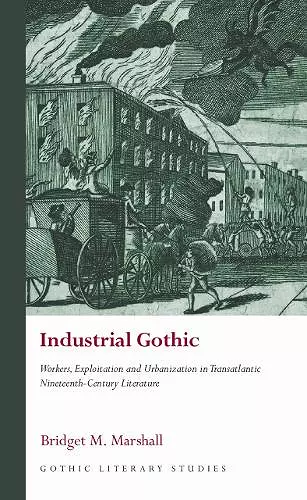Industrial Gothic
Workers, Exploitation and Urbanization in Transatlantic Nineteenth-Century Literature
Format:Hardback
Publisher:University of Wales Press
Published:15th Jun '21
Currently unavailable, our supplier has not provided us a restock date

• Transatlantic approach: This project explores British and American texts in conversation together. • Use of archival materials, which is relatively unusual within Gothic studies, and even in literary studies more generally. • A focus on poetry, drama, and periodical writing, genres that are often ignored in the study of the Gothic. • A focus on women’s work (both on the labor of women and on texts by women). • A focus on local Gothic (especially in Lowell and Manchester), with a connection to larger international trends of the genre.
The Gothic is more than just maidens-in-peril fleeing supernatural villains in another age. Historically, it was a form used to depict and critique the dangerous labour conditions faced by workers during the Industrial Revolution.This study carves out a new area of study, the 'industrial Gothic', placing the literature of the Industrial Revolution in dialogue with the Gothic. It explores a significant subset of transatlantic nineteenth-century literature that employs the tropes, themes and rhetoric of the Gothic to portray the real-life horrors of factory life, framing the Industrial Revolution as a site of Gothic excess and horror. Using archival materials from the nineteenth century, localised incidences of Gothic industrialisation (in specific cities like Lowell and Manchester) are considered alongside transnational connections and comparisons. The book argues that stories about the real horrors of factory life frequently employed the mode of the Gothic, while nineteenth century Gothic writing (stories, novels, poems and stage adaptations) began to use new settings - factories, mills, and industrial cities - as backdrops for the horrors that once populated Gothic castles.
"Industrial Gothic is a succinctly written, well-researched study, which demonstrates how in its early stages the Gothic offered a reservoir of rhetoric and imagery to powerfully expose and vilify social injustice suffered by the most vulnerable in an era of unprecedented and uncontrolled industrial expansion. Its great merit is undoubtedly creating a new critical category of 'Industrial Gothic' which goes beyond geographical, political and class divisions and encompasses a wide selection of texts, British and American, fiction and non-fiction, canonical and by unknown factory workers. By exploring the way the Gothic was used to depict damage caused by industry not only to human beings but also to the natural environment, Bridget Marshall’s book broadens our understanding of the Gothic as a powerful and effective mode directly engaged with the most acute problems of contemporary times." --Agnieszka Łowczanin, University of Łódź -- Agnieszka Lowczanin, University of Lódz * University of Wales Press *
"By drawing our attention to a literary form that was used by writers in both England and the United States, Marshall also reminds readers of the impact that industrialism had and continues to have on the global economy. Her study focuses on works that depict the horrors of the textile industry in the nineteenth century, but we in the twenty-first century are perhaps even more aware of the ongoing damage done by forces that have only become even more monstrous with the passage of time." * Journal of the Fantastic in the Arts *
ISBN: 9781786837707
Dimensions: unknown
Weight: unknown
288 pages